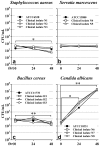Growth of microorganisms in total parenteral nutrition solutions without lipid
- PMID: 20107529
- PMCID: PMC2811814
- DOI: 10.7150/ijms.7.43
Growth of microorganisms in total parenteral nutrition solutions without lipid
Abstract
Background: To identify the microorganisms that can grow rapidly in total parenteral nutrition (TPN) solutions, we investigated the growth of the major causes of catheter-related blood stream infection (Staphylococcus aureus, Serratia marcescens, Bacillus cereus, and Candida albicans) in TPN solutions without lipid.
Methods: Experiment 1: A commercial TPN solution without lipid containing multivitamins (pH5.6) was used. A specific number of each test microorganism was added to each 10 mL of the TPN solution and incubated at room temperature. An aliquot of test solution was sampled and inoculated to SCD agar plates at 0, 24, and 48 hrs after the addition of the microorganisms. The number of microorganisms was counted as colony forming units. Experiment 2: The other 2 commercial TPN solutions without lipid (pH5.5) were supplemented with multivitamins. The pH values of the solutions were adjusted to about 6.0, 6.5, or 7.0 using 0.5 mol/L NaOH. The addition of microorganisms, incubation, and counting were performed in the same manner.
Results: Experiment 1: S. aureus, S. marcescens, and B. cereus did not increase in the TPN solution without lipid containing multivitamins (pH5.6), but C. albicans increased rapidly. Experiment 2: The 3 bacterial species did not increase even at pH6.0, but increased at pH6.5 and increased rapidly at pH7.0 in both TPN solutions. C. albicans increased similarly at any pH.
Conclusion: These results suggest that bacterial species cannot grow in TPN solutions without lipid due to the acidity (pH5.6 or lower), but Candida species can grow regardless of the acidity.
Keywords: CRBSI; TPN solution; growth of microorganism; microbial growth; pH.
Conflict of interest statement
CONFLICT OF INTERESTS: The authors have declared that no conflict of interest exists.
Figures





References
-
- Mermel LA, Farr BM, Sherertz RJ. et al.Guidelines for the management of intravascular catheter-related infections. Clin Infect Dis. 2001;32:1249–1272. - PubMed
-
- Llop J, Badia MB, Comas D, Tubau M, Jodar R. Colonization and bacteremia risk factors in parenteral nutrition catheterization. Clin Nutr. 2001;20:527–534. - PubMed
-
- Banton J. Techniques to prevent central venous catheter infection: products, research, and recommendations. Nutr Clin Pract. 2006;21:56–61. - PubMed
-
- Allwood MC. Microbiological risks in parenteral nutrition compounding. Nutrition. 1997;13:60–61. - PubMed
-
- Shimono K, Kaneda S, Kuwahara T, Kawaguchi Y, Momii A. Effects of lipid and multivitamins on the growth of Staphylococcus aureus in peripheral parenteral nutrition solutions. Clin Nutr. 2005;24:706–707.
Publication types
MeSH terms
Substances
LinkOut - more resources
Full Text Sources
Other Literature Sources
Research Materials

